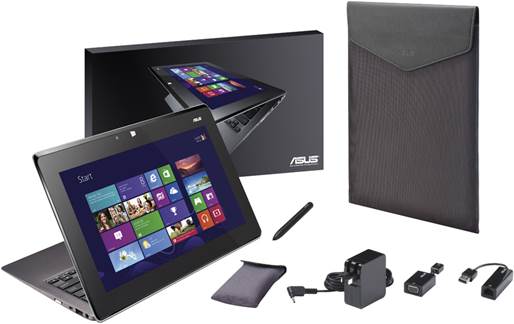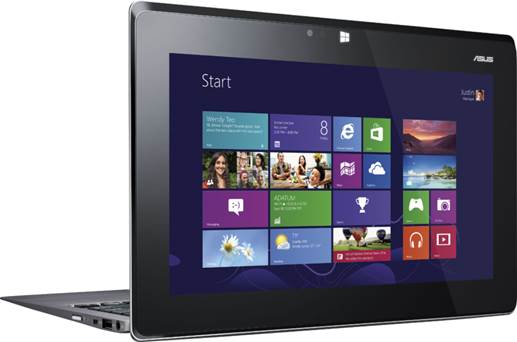It's hard to forget Asus Taichi: among Windows
8 convertible laptops we've seen, this is the first one with two screens available.
Specifically, it has one inside which you use in regular laptop mode, along
with a touchscreen outside that allows you to use PC as a tablet.
If you like, you can shut the lid
completely and turn the machine into a laptop type, but you can also leave the
lid open to reflect your desktop, or display something different the other one
(imagine the potentialities for presenters!). As an additional trick, the outer
screen also accepts pen input, though you'll have to spend much money on the
highest-class configuration to get with a stylus.

Among
all Windows 8 convertible laptops we've seen, this is the first one with two
screens available.
At this time, Asus is selling the 11.6-inch
Taichi 21 (1,299 USD and higher), although a 13-inch version will begin to be
sold after this month. Still, it’s hopefully that our review will answer
questions you'd have about these models. Namely, what's it like to use a laptop
with two screens?
Design and feel
Until now, our reviews about Asus Ultrabooks
ARE starting to become repetitively. Clearly, the company mounted a touchscreen
on one of the old models, but otherwise, the core design hasn't changed much in
the past year. Zenbooks line has always been flashy, with metal lids and
brushed-metal palm rests that contrast with the keyboard. Taichi is also
eye-catching, but in a different way. First, there's no metal cover here - the
"lid" is actually that secondary screen. Inside, the keyboard tray has
a putty color that mixes up with the black keyboard. Even the brushed-metal
detail seems a little sleek here. In brief, it's an attractive, elegant design.
There’s nothing to criticize. This makes sense when you consider that Asus is
mainly aimed toward business users.
With the lid shut, it doesn't actually look
that different from HP Envy 14 Spectre, or Acer Aspire S7, or any other laptop
with a glass lid. The difference is that you can see the matte outline of the
bezel - the kind of thick border you'll find on a typical tablet. There's also
a touch-sensitive Start button that emit white light when the machine is on. It’s
same for ASUS' logo, which locates in one corner.

There's
no metal cover here - the "lid" is actually that secondary screen.
Inside, the keyboard tray has a putty color that mixes up with the black
keyboard.
The effect is pretty precise - until you start
using the Taichi as a tablet. Because most other laptops with glass covers are
primarily used for decorative purposes, it’s not sure that you will touch them frequently.
Here, it's a necessity. Fingerprints are a kind of thing causes eyesore,
especially when the machine is powered off. As that's the only part of the
laptop you can see when it's closed, you'd better prepare to keep it‘s thirteen
hundred USD worth. On the positive side, Asus used a custom glass (not Gorilla)
which has proved to be very resilient in our tests. Even after we tossed it in
a rucksack to shuttle from the office, it didn't have any scratches.
We have mixed feelings about the internal
display: though the viewing angles are good, it doesn't support touch, which
means you don't have the option of reaching your arms up to tap it while using
this thing as a regular laptop. Moreover, the panel is surrounded by a thick,
1-inch bezel that makes the inside feel a little outdated; something closer to the
edge-to-edge screen would have easily made the machine look more modern. Even with
one touchscreen, it is heavier than other 11-inch laptops, with 2.75 pounds. In
the weight perspective, it’s between the 11- and 13-inch MacBook Air, so we
can't imagine how solid this laptop will be if there actually are a second
touchscreen on board.
The good news is that Taichi is slightly
thin, with 0.69 inch - not bad based on that it has two screens on board. The
chassis is thick enough to make room for two USB 3.0 ports, along with
micro-HDMI, mini-VGA, a volume rocker, an audio jack, a screen lock and a
slider to power the device. Besides, Taichi comes with a USB-to-Ethernet
adapter, a micro-HDMI-to-VGA dongle and, on selecting models, a pressure-sensitive
pen. Like other high-class Asus laptops, it even has a bag for the adapters and
a matching case for the laptop, which gains extra points thanks to its leather cover,
magnetic closure and slot for holding the stylus.